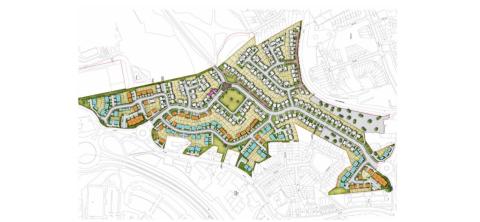How do you turn a site with a history of mining, heavy industry and scrapyard use into sustainable regeneration opportunity? A factory closure brought this site into public ownership. It is now a mixed tenure housing development linked by extensive open green space and infrastructure providing wider regeneration benefits. September 2022.
Introduction
City of Wolverhampton Council: Bilston Urban Village, Bilston
“In this planning team, we talk about the art of the possible. That's what we achieve working collaboratively with the developer, with internal and external consultees so we can say, ‘that is what is possible’.” (Local Planning Officer).
… the fact that there was an SPD… demonstrates the ambition of the Council… a real positive… masterplan gives us all certainty that it all fits together… the Council have invested not insignificant resource…they were serious about making sure this was delivered…” (Developer)
This site became available in 1996 after the closure of a large factory complex owned by GKN Sankey. It came into public ownership and is a strategic opportunity for sustainable regeneration. The scheme contributes to the delivery of long-term housing and employment targets within the wider Black Country Corridor.
Bilston Urban Village is a mixed-use development comprising:
- mixed tenure housing (498 units; 25% affordable)
- the Council’s flagship leisure complex
- a Secondary school and relocated and enlarged primary school
- a public house
The development is linked by extensive open green space. It includes a Sustainable Drainage System (SUDS) pond managed by the Land Trust. Some employment land to the north-east of the site remains undeveloped by the LPA. Infrastructure that links the site to the centre of Bilston also provides wider regeneration benefits.
Key Success Factors
Planning
- Leadership of place by the council drove the vision for this complex site forward. Strong leadership and ambition helped overcome the challenges inherent in the site. This meant that the risks associated with ground conditions, infrastructure, and economic conditions were met head-on. It ensured the delivery of a coherent and viable mixed-use development.
- Powers of compulsory purchase gave the council title across the entire site. This meant that a strategic approach could be taken to the development of the site.
- Exercising a range of planning tools to resolve issues when developing a challenging site. For example, the creation of Supplementary Planning Document (SPD) to set out the development framework for the site.
- Efficient discharge of planning conditions applications. This encouraged the Developer to submit comprehensive applications. Confidence that applications would be dealt with quickly encouraged a less fragmented approach.
- Productive team working, continuity and clear, consistent communication. Bringing this development forward involved a lengthy and complex process. It required clear and well-facilitated interaction between planning, regeneration, members and the developer. Achieving continuity of planning staff input was also key to getting decisions made. The council were also reliant on in-house development and regeneration skills.
Key Planning Tools
- A Supplementary Planning Document (SPD) set out the development framework.
- The Council’s use of compulsory purchase (CPO) power.
- A Section 111 (S111) Agreement. This gives subsidiary powers for local authorities to discharge their functions. It allowed the council to act as decision-maker on its own application. It also allowed the council to enter into a Section 106 (developer contributions) agreement with the developer. The S111 Agreement committed the developer to future S106 obligations.
- A Strategic Masterplan was submitted with the outline application.
Site Identification
- Local Authority Land. The council made the site available for development. Outline planning permission was initially granted to the Regional Development Agency, Advantage West Midlands (AWM), in 2002.
- The City of Wolverhampton Council Unitary Development Plan (2006) allocated Bilston Urban Village as a Strategic Regeneration Area.
-
The Black Country Core Strategy (2011) (a spatial plan for the Boroughs of Dudley, Sandwell, Walsall and the City of Wolverhampton) confirmed the status of the site as an Urban Village Opportunity. It identified the area as a key opportunity within the sub-regional ‘Growth Network’.
- The Bilston Corridor Area Action Plan 2013-2026. This guided the transformation of the Bilston Corridor area. Following detailed evidence and consultation, the site was allocated as mixed use.
- Supplementary Planning Document for Bilston Urban Village (2013). This set a development framework for the proposed uses, the site constraints and other planning guidance.
Site Viability
- Up front funding for remediation and infrastructure. Developers need confidence if they are going to commit to developing a brownfield site. Up front remediation and mitigation works were funded by Homes England and the Black Country Local Enterprise Partnership (LEP). This helped with viability, reducing risks and costs for potential developers.
- Mixed tenure and affordable housing. The LPA worked with Kier Living Limited, Tilia Homes and Countryside Properties. They secured mixed-tenure housing and a commitment to 25% affordable housing provision. Developers viewed the site as an opportunity for large scale development.
- Supporting broader City Centre Regeneration. The development has supported the council’s broader City Centre regeneration objectives. The development provides the new community with infrastructure linking it to the centre of Bilston.
Lessons Learned
- Leadership - Bringing a complex brownfield site forward requires strong leadership. The LPA lead by example, facilitating good communication between all parties.
- Early master planning and preliminary remediation are fundamental to securing developer confidence. Understanding the site's capacity, constraints and risk mitigation requirements, helps to secure viable developer investment.
- Expect the unexpected. Unknown risks often impact brownfield sites. Unrecorded mine shafts changed both developer costs and development layout. Being prepared for challenges allows for pragmatism - they don't have to be 'show-stoppers'. A pragmatic approach encourages dynamic and creative solutions.
- Coherent Supplementary Planning Documents provide an overall vision for the development. They prompt and facilitate early stakeholder engagement through the pre-application process.
- Detailed and transparent pre-application discussions allow developers to submit applications which move through the planning process with greater efficiency.



